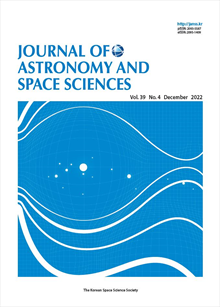간행물
Journal of Astronomy and Space Sciences KCI 등재 SCOPUS

- 발행기관 한국우주과학회
- 자료유형 학술지
- 간기 계간
- ISSN 2093-5587 (Print)2093-1409 (Online)
- 수록기간 1984 ~ 2022
- 주제분류 자연과학 > 천문학 자연과학 분류의 다른 간행물
- 십진분류KDC 443DDC 520
권호리스트/논문검색
제39권 1호 (2022년 3월) 2건
1.
2022.03
서비스 종료(열람 제한)
The universe is thought to be filled with not only Standard Model (SM) matters but also dark matters. Dark matter is thought to play a major role in its construction. However, the identity of dark matter is as yet unknown, with various search methods from astrophysical observartion to particle collider experiments. Because of the cross-section that is a thousand times smaller than SM particles, dark matter research requires a large amount of data processing. Therefore, optimization and parallelization in High Performance Computing is required. Dark matter in hypothetical hidden sector is though to be connected to dark photons which carries forces similar to photons in electromagnetism. In the recent analysis, it was studied using the decays of a dark photon at collider experiments. Based on this, we studies double dark photon decays at lepton colliders. The signal channels are e+e– → AʹAʹ and e+e– → AʹAʹγ where dark photon Aʹ decays dimuon. These signal channels are based on the theory that dark photons only decay into heavily charged leptons, which can explain the muon magnetic momentum anomaly. We scanned the cross-section according to the dark photon mass in experiments. MadGraph5 was used to generate events based on a simplified model. Additionally, to get the maximum expected number of events for the double dark photon channel, the detector efficiency for several center of mass (CM) energy were studied using Delphes and MadAnalysis5 for performance comparison. The results of this study will contribute to the search for double dark photon channels at lepton colliders.
2.
2022.03
서비스 종료(열람 제한)
It is suggested that magnetosonic waves (also known as equatorial noise) can scatter radiation belt electrons in the Earth’s magnetosphere. Therefore, it is important to understand the global distribution of these waves between the proton cyclotron frequency and the lower hybrid resonance frequency. In this study, we developed an empirical model for estimating the global distribution of magnetosonic wave amplitudes and wave normal angles. The model is based on the entire mission period (approximately 2012–2019) of observations of Van Allen Probes A and B as a function of the distance from the Earth (denoted by L*), magnetic local time (MLT), magnetic latitude (λ), and geomagnetic activity (denoted by the Kp index). In previous studies the wave distribution inside and outside the plasmasphere were separately investigated and modeled. Our model, on the other hand, identifies the wave distribution along with the ambient plasma environment—defined by the ratio of the plasma frequency (fpe) to the electron cyclotron frequency (fce)—without separately determining the wave distribution according to the plasmapause location. The model results show that, as Kp increases, the dayside wave amplitude in the equatorial region intensifies. It thereby propagates the intense region towards the wider MLT and inward to L* < 4. In contrast, the fpe/fce ratio decreases with increasing Kp for all regions. Nevertheless, the decreasing aspect differs between regions above and below L* = 4. This finding implies that the particle energy and pitch angle that magnetosonic waves can effectively scatter vary depending on the locations and geomagnetic activity. Our model agrees with the statistically observed wave distribution and ambient plasma environment with a coefficient of determination of > 0.9. The model is valid in all MLTs, 2 ≤ L* < 6, |λ| < 20°, and Kp ≤ 6.

